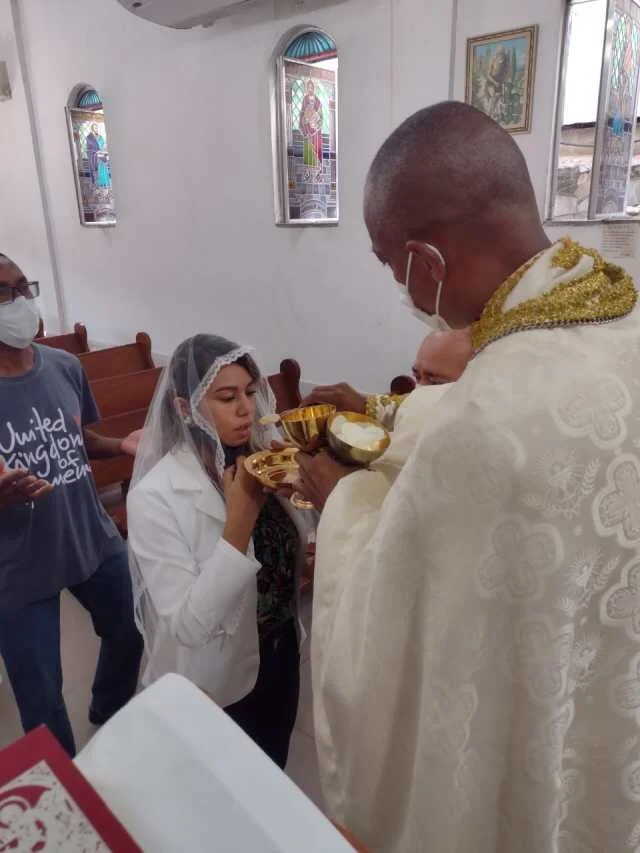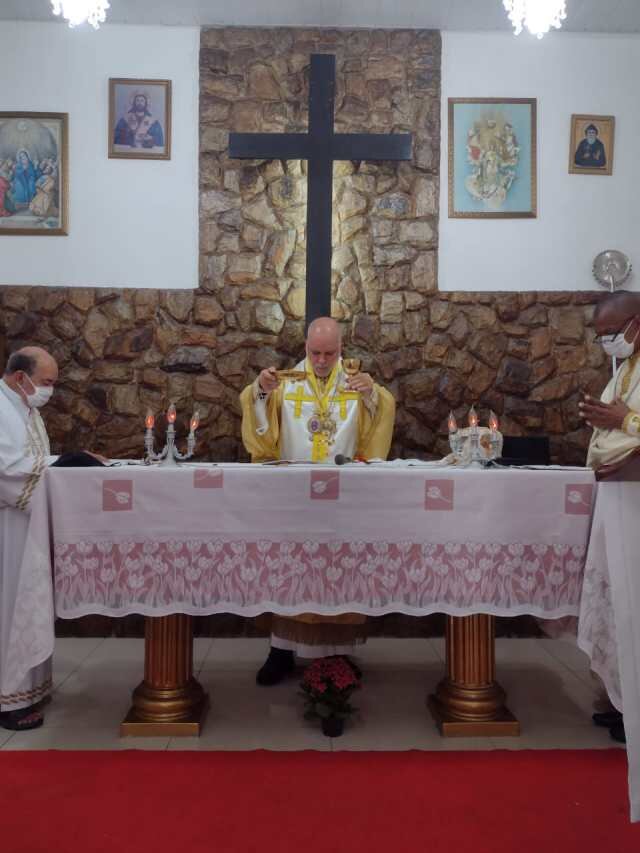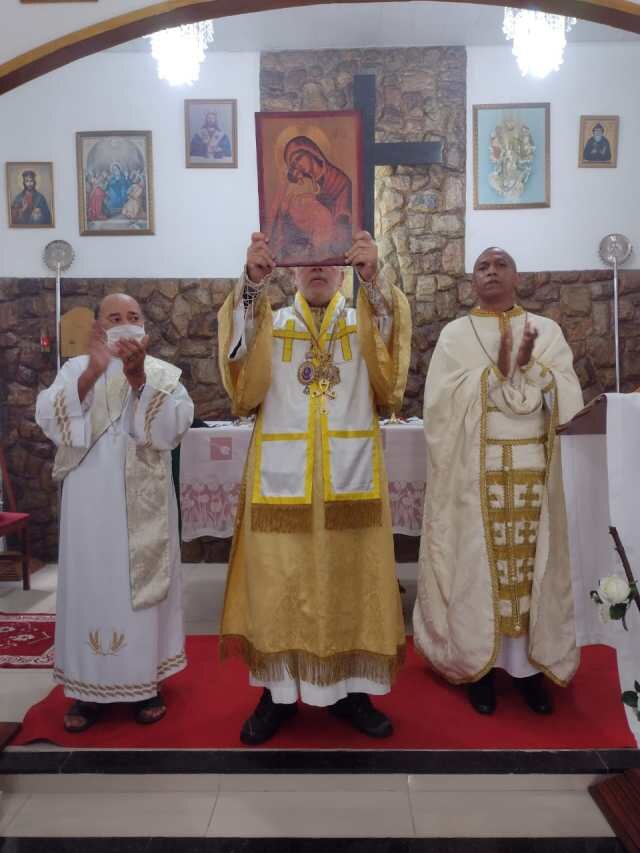American World Patriarchates and the
Order of Corporate Reunion
The American World Patriarchates, sometimes referred to as American World Patriarchs, is an international autocephalous movement within Orthodoxy that has existed for over fifty years. It was established by Uladyslau Ryzy-Ryski (1925-78), a Byelorussian priest who during the 1960s came into contact with Patriarch Wolodymyr (Walter Myron Propheta) (1912-72) of the American Orthodox Catholic Church. The AOCC, which was incorporated in 1965, was an attempt to build an indigenous American Orthodoxy inspired by the earlier example of Archbishop Aftimios Ofiesh (1880-1966), being non-ethnically and non-nationally established and welcoming all who sought Orthodoxy. Patriarch Wolodymyr based his church upon a steadfast witness to the seven Ecumenical Councils but allowed his bishops a free choice of liturgical and other matters provided these were in accordance with an Orthodox understanding.
On Christmas Day 1965, Patriarch Peter Zhurawetzky (who was recognized by the Ecumenical Patriarch) then-acting Archbishop of Miensk and all Byelorussia of the Apostolic Synod of “SUBOZHNIA” and Patriarch of the Holy Orthodox Catholic Patriarchate of America elevated to the rank of Archbishop and consecrated Ryzy-Ryski, to be the Apostolic Administrator of the Byelorussian Orthodox Catholic Church of St Apostle Andrew in both the Eastern and Western Rite. Ryzy-Ryski also served as Chancellor to the Holy Orthodox Catholic Patriarchate of America.
In 1967, without leaving Patriarch Wolodymyr’s jurisdiction, Ryzy-Ryski began a new mission, the American World Patriarchates, and became known as Patriarch Uladyslau I. This loosely-structured mission sought to create an international hierarchy of bishops. It was formally separated from the jurisdiction of Patriarch Wolodymyr when, just before his death in 1972, Patriarch Wolodymyr excommunicated Patriarch Uladyslau.
The work of Patriarch Uladyslau was organized from the Bronx in New York, where he established a Cathedral of Learning and the People’s University of the Americas. This offered courses in English as a second language and the humanities for immigrants (particularly Spanish-speakers) at affordable fees, and became extremely popular. Meanwhile, the American World Patriarchates expanded with the appointment of patriarchs for Puerto Rico, Colombia, Haiti, Santo Domingo, Brazil, Peru, Argentina, El Salvador, Nigeria, the West Indies, Norway, Sweden, Taiwan and the Ukraine. On 26 December 1976, Patriarch Uladyslau appointed Archbishop Viktor Ivan Busa as Archeparch Metropolitan of Byalystock and Coadjutor Patriarch of Byelorussia. During this period, the American World Patriarchates, together with Patriarch Zhurawetsky and Patriarch Busa, entered into full intercommunion with the Apostolic Episcopal Church. Francis C. Spataro, who was ordained priest by Patriarch Uladyslau in 1976, would serve as Primate of the AEC between 1998 and 2015.
Patriarch Uladyslau’s brother Emigidiusz Jerzy Ryzy (who took the religious name Yuri), had spent his entire adult life in exile. In Poland, where he lived in the city of Ustka, he trained and worked as an engineer for over a decade. He came to the United States in 1976 and began training for ordination the following year. His rapid advancement was in recognition of the responsibilities that his brother’s illness would soon require him to assume.
When Patriarch Uladyslau died on 1 March 1978 he was succeeded by his brother, who had been consecrated on February 19 that same year by Patriarch Uladyslau, Patriarch Peter Zhurawetsky and other bishops, and who now became Patriarch Yuri I. On 29 May 1978, Patriarch Zhurawetzky elevated Patriarch Yuri to be Apostolic Administrator of the American World Patriarchates while still recognizing him to be a Bishop of his own Byelorussian jurisdiction, the Byelorussian Orthodox National Church in Exile. In accordance with the previous appointment, Archbishop Viktor Busa was now Patriarch of Byelorussia within the AWP.
Under Patriarch Yuri the American World Patriarchates continued its growth and mission. By 1997, the AWP could report 19,457 members, 17 congregations, and 54 priests in the United States; one congregation with three priests in Canada, and work affiliated with the AWP taking place in 17 additional countries.
A great wish of Patriarch Uladyslau was that he should re-establish Orthodoxy in his homeland of Byelorussia (Belarus). This was accomplished under Patriarch Yuri during the 1990s and at this point congregational numbers began to increase substantially. His first visit to his homeland since childhood took place in 1993, and thereafter he returned annually. As of 1993, there was one bishop there, six assisting priests in Minsk, Lida, and Siomki Goradok, and a lay membership of thirty-five thousand which was continuing to grow. However, this activity was opposed by the post-Soviet Belarusian regime, and the Russian Orthodox Church, which suppressed many of the churches that had opened.
On January 28 2001, Patriarch Yuri was also raised to the office of Archbishop of the Holy Orthodox Church, Archdiocese of the Atlantic, by bishops of the Uniate Western Orthodox Catholic Church, the Apostolic Episcopal Church, the African Orthodox Church, the Order of St Benedict the Moor, the Anglican Independent Communion and the Order of Corporate Reunion in St. John’s Episcopal American Catholic Church, New York City. At this point, Patriarch Viktor Busa separated his work from that of Patriarch Yuri. Patriarch Viktor was succeeded at his death by Patriarch Athanasius (Luiz Antonio do Nascimento), who was resident in Brazil. Patriarch Athanasius then reunited his church with Patriarch Yuri, bringing it once more within the AWP and the Byelorussian Orthodox National Church in Exile.
Patriarch Yuri died in 2015. While he had designated a successor, on two occasions a service was arranged for that successor to accept episcopal consecration and elevation to the patriarchate, only for him to refuse and withdraw from participation on the basis that he was not spiritually and temporally ready to accept this responsibility. This led to an unfortunate position of uncertainty and stasis in which there was no clear leadership or continuation of the AWP. The deliberately loose structure of the AWP did not provide for synodical governance, since each patriarch was independent jurisdictionally and the role of the Apostolic Administrator was co-ordinating and advisory in nature rather than a ruling power.
Having studied the history of the AWP closely, the position we take today is that every patriarch of the AWP (or metropolitan in the event of a patriarchal vacancy) is fully autonomous and may appoint others to membership as is their wish. There is not and has never been any comprehensive central register of membership, nor any canons or statutes save for the universal tenets of the Orthodox Faith. James Lewis says of the AWP, “The World Patriarchate was very loosely structured, and established in large part by the elevation to patriarchial status of other independent bishops not otherwise required to recognize Ryzy-Ryski’s authority or come under his jurisdiction.” Regardless of any vacancy in the position of Apostolic Administrator, the AWP remains the jurisdiction to which its clergy affiliate, maintaining its original broad definition of Orthodoxy and promoting the collaboration of the AWP with other like-minded jurisdictions as has been the case throughout its history. While the number of patriarchs and other clergy and laity is potentially unlimited, there has never been any central primacy, and apparently no formal regulation as to the appointment of patriarchs. Contrary to the falsehoods that have been promoted by some, the AWP was never a hereditary possession of the Ryzy family. Since its worldwide membership remains unknown and its patriarchs can affiliate clergy and laity without limitation or reference to the Apostolic Administrator, it can never be governed as a whole in any hierarchical or canonical manner, and this decentralization appears to have been entirely deliberate in its founding structure. Individual patriarchs, however, remain free to establish their own administration for their respective patriarchates. Over the years, there have been some differences between patriarchates of the AWP regarding the ordination of men before or after marriage, and it has also been reported that some patriarchates have permitted the ordination of women as deacons (as is today the case in the Greek Orthodox Church).
When Patriarch Athanasius died in 2018, his church split into two factions, with that led by the late Metropolitan Dom Nagui Youssef Zagat reuniting in the following year with Patriarch Zhurawetsky’s former jurisdiction, the Byelorussian Patriarchate of St Andrew the First-Called Apostle (which together with the Apostolic Episcopal Church and Order of Corporate Reunion, is a member jurisdiction of the Catholicate of the West). Dom Nagui died in 2021 and was succeeded by the present Metropolitan, Dom Bartholomews. He is based at the Cathedral of St George and St Sebastian in Rio de Janeiro.
The present role of the Catholicate of the West with respect to the AWP has come about as a result of the need for administration among its remaining clergy and laity who are now members of the Catholicate, together with the comprehensive failure of the post-2015 succession plans. It rests in particular on the forty-year intercommunion between the AWP and the Apostolic Episcopal Church (AEC), a member jurisdiction of the Catholicate. The AEC was recognized by legislative charter of the State of New York in 1932 and is an ecumenical communion with wide links across Orthodoxy and related traditions. It was first recognized by the Ecumenical Patriarchate in 1930 through Archbishop Damaskinos, then acting as the ambassador in the United States of Photios II, Ecumenical Patriarch of Constantinople. The AEC enjoyed full intercommunion with Patriarch Peter II Zhurawetsky, Patriarch Uladyslau, Prince Kermit of Miensk (Ecclesiast of the Byelorussian Patriarchate of St Andrew), Patriarch Yuri I, Patriarch Viktor Busa, and the American Orthodox Catholic Church, and thus forms a bridge between all of the churches discussed above. The Catholicate exercises a paternal role of administration in respect of the AWP as it is constituted under its aegis, while acknowledging that due to the nature of the AWP as a loose religious confederation, there will be other clergy and laity who are AWP members while not being affiliated with the Catholicate.
Taken from the official page of the the Abbey-Principality of San Luigi
Written by Archbishop +John Kersey, O.C.R., Prelate of the Order





